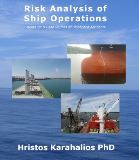The increasing cases of collisions and groundings have exposed the disregard of some navigation officers and masters of the IMO guidelines for voyage planning. Someone may claim that the responsibility is on a ship management company to have comprehensive navigation procedures to guide its deck officers. However, the deck officer is obligated not to overlook the risks associated with practical navigation neither to violate international rules. Below, we summarize COLREGS 1972 requirements and related interpretation from some authorities.
COLREG Rule 6 (Safe Speed)
Navigators must give priority to ship’s speed changes when it is in narrow waters. In particular, attention is needed to the following points (Swedish Accident Investigation Authority Report RS 2016:07e 2015):
- The ship’s speed in route planning for the entire voyage in narrow waters should be the same with that of the squat calculation.
- There is a significant difference between the vessels draught in shallow waters depending on the speed, which can lead to risks.
COLREG Rule 13 (Overtaking)
AMSA released an advisory note regarding close proximity manoeuvres and overtaking situations in narrow waters. The Australian authority described the following hazards:
- Close-quarters events between piloted vessels reflect that a lack of communication between vessels in close proximity increases the potential for an incident.
- Vessels altering course and/or speed in close proximity to another, especially in overtaking, should give a call on VHF radio before the manoeuvre
- The other vessel should confirm that is aware of your intentions and is safe to proceed.
- When overtaking, pilots should also be mindful of not reducing speed too soon after conducting the overtaking manoeuvre.
- Pilots & Captains must follow requirements and obligations relevant to manoeuvring and overtaking, should also pay attention to the following COLREGS:
- Rule 34(c) (Manoeuvring and Warning Signals)
- Rule 34(d) (Manoeuvring and Warning Signals)
Rule 9(e) (Narrow Channels)
The USCG and other societies examined the challenges with the definition of Narrow Waters. The USA authorities concluded that it is a necessity to set criteria for designating narrow channels or fairways throughout the nation’s 25,000 miles of waterways for the following reasons:
- There is a contrast between Rule 9, which leaves it to the mariners to determine when the rule applies.
- The multi-factor Rule 9 analysis adopted by courts in collision cases is complicated,and the need for a case-by-case analysis of the relevant factors might well delay the mariners’ collision-avoidance action.
- Rule 10 applies only when the waters have been designated as a traffic separation scheme.
Company’s Safety Management System
In the aftermath of a collision when a pilot was onboard the Malta Investigation authority concluded that Company’s Safety Management Systems should include the following procedures (Malta Safety Investigation Report 2012904/039 Report NO.: 09/2020 April 2020):
- Master, or, in his absence, the duty officer, has the ultimate command of the vessel
- The presence of a pilot on board does not absolve the master or the duty officer from this responsibility
- Navigation by pilot shall be monitored continuously by bridge team and the duty officer shall ensure that the pilot's advice is acknowledged
- If the master, or, in his absence, the duty officer, finds the pilot's navigation faulty and that it may create hazardous situation(s) for the vessel, crew or cargo, he shall take appropriate action:
Appropriate action may include relieving the pilot of direct command, and shall be affected by a statement: ‘pilot, I take over’.
When the hazardous situation is clear, the master, at his discretion, may handover navigation to the pilot, subject to the pilot's clear acknowledgement.
- Special attention needs to be drawn to precautions during sailing in shallow and congested waters
- Training of masters and navigational officers to be carried out regularly for the operation of vessels in inland waterways, bottom and bank suction/cushion effect, and checked by SQ Manager during regular visits on board
- Assessment of risks before entering shallow waters shall be carried out and risks re-assessed while sailing through these waters.

